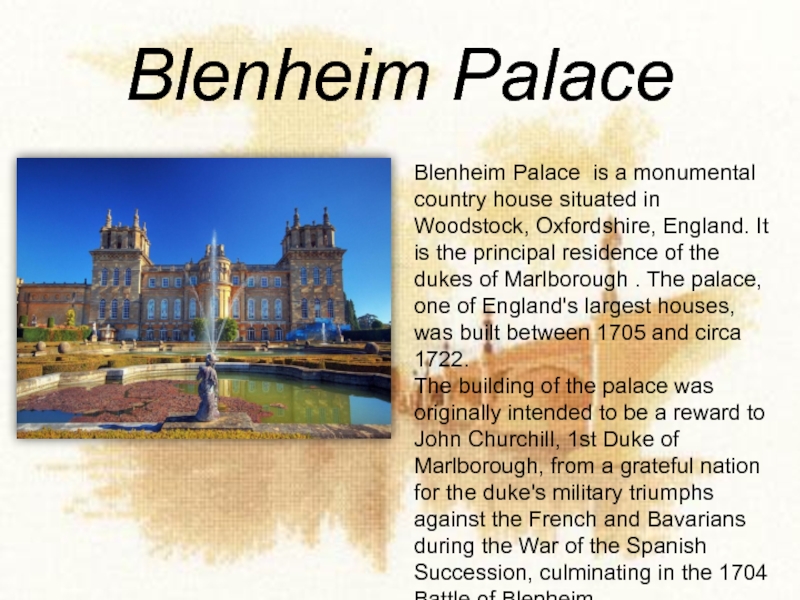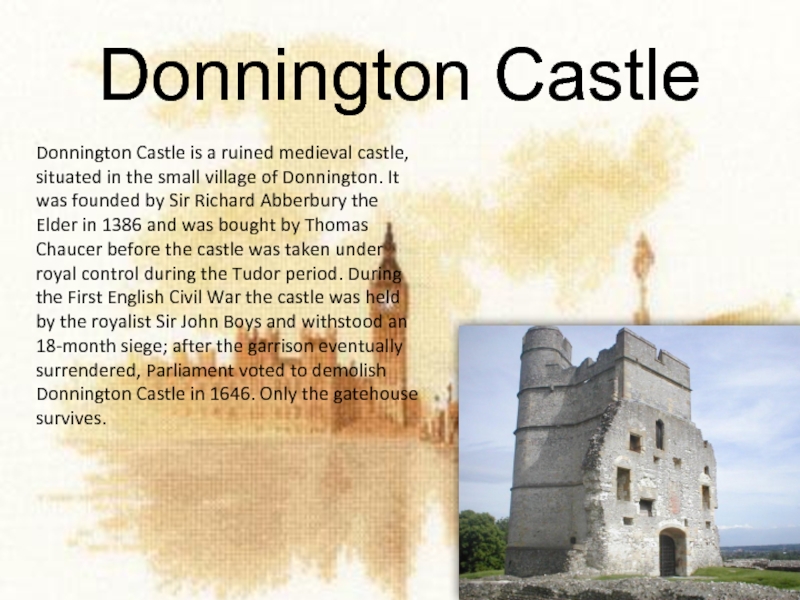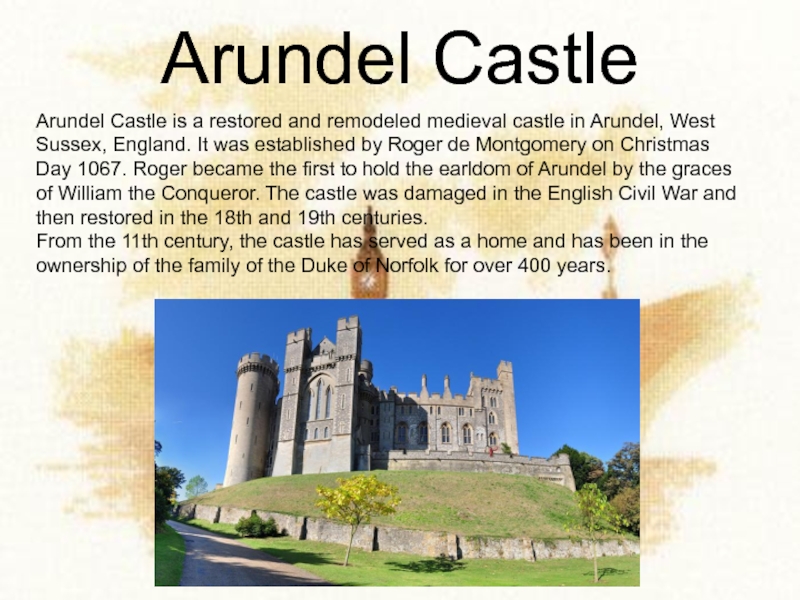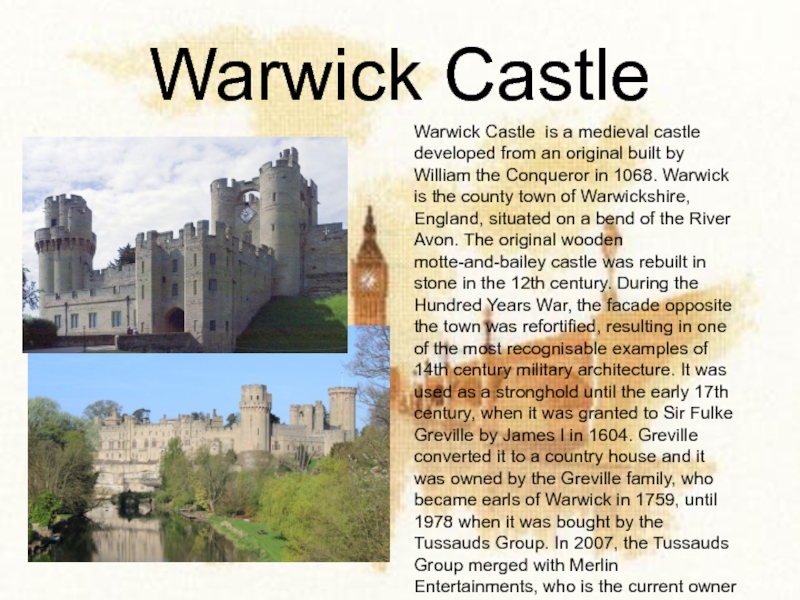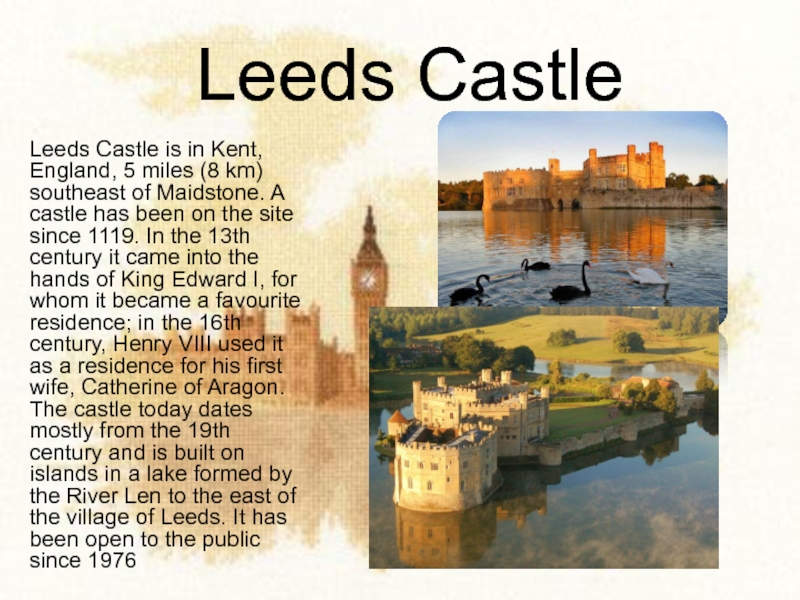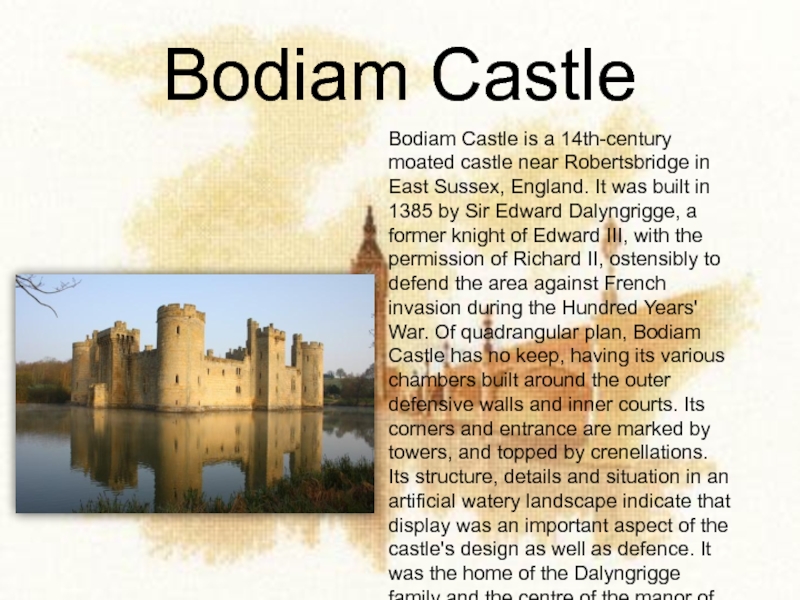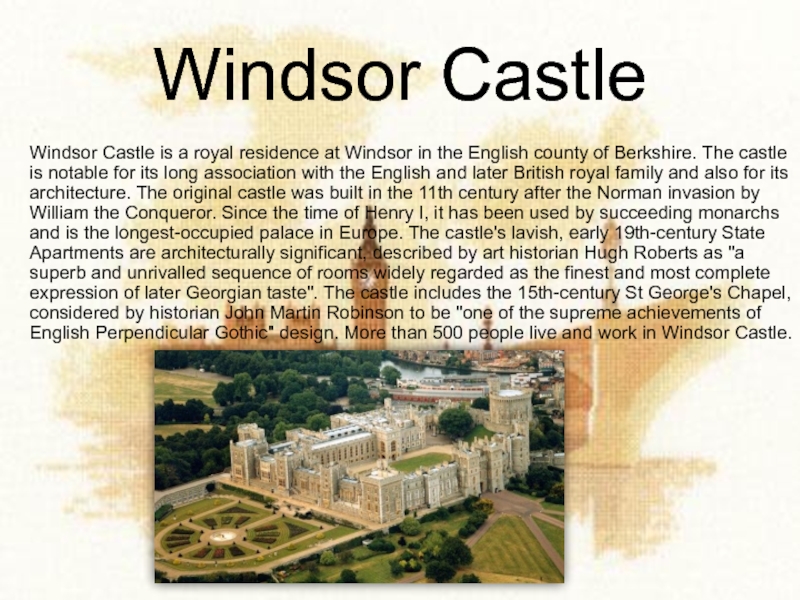- Главная
- Разное
- Дизайн
- Бизнес и предпринимательство
- Аналитика
- Образование
- Развлечения
- Красота и здоровье
- Финансы
- Государство
- Путешествия
- Спорт
- Недвижимость
- Армия
- Графика
- Культурология
- Еда и кулинария
- Лингвистика
- Английский язык
- Астрономия
- Алгебра
- Биология
- География
- Детские презентации
- Информатика
- История
- Литература
- Маркетинг
- Математика
- Медицина
- Менеджмент
- Музыка
- МХК
- Немецкий язык
- ОБЖ
- Обществознание
- Окружающий мир
- Педагогика
- Русский язык
- Технология
- Физика
- Философия
- Химия
- Шаблоны, картинки для презентаций
- Экология
- Экономика
- Юриспруденция
Castles of England презентация
Содержание
- 1. Castles of England
- 2. Blenheim Palace Blenheim Palace is a monumental
- 3. Donnington Castle Donnington Castle is
- 4. Arundel Castle Arundel Castle is
- 5. Warwick Castle Warwick Castle is a medieval
- 6. Leeds Castle Leeds Castle is in Kent,
- 7. Bodiam Castle Bodiam Castle
- 8. Windsor Castle Windsor Castle is
Слайд 2Blenheim Palace
Blenheim Palace is a monumental country house situated in Woodstock,
Oxfordshire, England. It is the principal residence of the dukes of Marlborough . The palace, one of England's largest houses, was built between 1705 and circa 1722.
The building of the palace was originally intended to be a reward to John Churchill, 1st Duke of Marlborough, from a grateful nation for the duke's military triumphs against the French and Bavarians during the War of the Spanish Succession, culminating in the 1704 Battle of Blenheim.
The building of the palace was originally intended to be a reward to John Churchill, 1st Duke of Marlborough, from a grateful nation for the duke's military triumphs against the French and Bavarians during the War of the Spanish Succession, culminating in the 1704 Battle of Blenheim.
Слайд 3
Donnington Castle
Donnington Castle is a ruined medieval castle, situated in the
small village of Donnington. It was founded by Sir Richard Abberbury the Elder in 1386 and was bought by Thomas Chaucer before the castle was taken under royal control during the Tudor period. During the First English Civil War the castle was held by the royalist Sir John Boys and withstood an 18-month siege; after the garrison eventually surrendered, Parliament voted to demolish Donnington Castle in 1646. Only the gatehouse survives.
Слайд 4
Arundel Castle
Arundel Castle is a restored and remodeled medieval castle in
Arundel, West Sussex, England. It was established by Roger de Montgomery on Christmas Day 1067. Roger became the first to hold the earldom of Arundel by the graces of William the Conqueror. The castle was damaged in the English Civil War and then restored in the 18th and 19th centuries.
From the 11th century, the castle has served as a home and has been in the ownership of the family of the Duke of Norfolk for over 400 years.
From the 11th century, the castle has served as a home and has been in the ownership of the family of the Duke of Norfolk for over 400 years.
Слайд 5Warwick Castle
Warwick Castle is a medieval castle developed from an original
built by William the Conqueror in 1068. Warwick is the county town of Warwickshire, England, situated on a bend of the River Avon. The original wooden motte-and-bailey castle was rebuilt in stone in the 12th century. During the Hundred Years War, the facade opposite the town was refortified, resulting in one of the most recognisable examples of 14th century military architecture. It was used as a stronghold until the early 17th century, when it was granted to Sir Fulke Greville by James I in 1604. Greville converted it to a country house and it was owned by the Greville family, who became earls of Warwick in 1759, until 1978 when it was bought by the Tussauds Group. In 2007, the Tussauds Group merged with Merlin Entertainments, who is the current owner of Warwick Castle.
Слайд 6 Leeds Castle
Leeds Castle is in Kent, England, 5 miles (8 km)
southeast of Maidstone. A castle has been on the site since 1119. In the 13th century it came into the hands of King Edward I, for whom it became a favourite residence; in the 16th century, Henry VIII used it as a residence for his first wife, Catherine of Aragon. The castle today dates mostly from the 19th century and is built on islands in a lake formed by the River Len to the east of the village of Leeds. It has been open to the public since 1976
Слайд 7
Bodiam Castle
Bodiam Castle is a 14th-century moated castle near Robertsbridge in
East Sussex, England. It was built in 1385 by Sir Edward Dalyngrigge, a former knight of Edward III, with the permission of Richard II, ostensibly to defend the area against French invasion during the Hundred Years' War. Of quadrangular plan, Bodiam Castle has no keep, having its various chambers built around the outer defensive walls and inner courts. Its corners and entrance are marked by towers, and topped by crenellations. Its structure, details and situation in an artificial watery landscape indicate that display was an important aspect of the castle's design as well as defence. It was the home of the Dalyngrigge family and the centre of the manor of Bodiam.
Слайд 8
Windsor Castle
Windsor Castle is a royal residence at Windsor in the
English county of Berkshire. The castle is notable for its long association with the English and later British royal family and also for its architecture. The original castle was built in the 11th century after the Norman invasion by William the Conqueror. Since the time of Henry I, it has been used by succeeding monarchs and is the longest-occupied palace in Europe. The castle's lavish, early 19th-century State Apartments are architecturally significant, described by art historian Hugh Roberts as "a superb and unrivalled sequence of rooms widely regarded as the finest and most complete expression of later Georgian taste". The castle includes the 15th-century St George's Chapel, considered by historian John Martin Robinson to be "one of the supreme achievements of English Perpendicular Gothic" design. More than 500 people live and work in Windsor Castle.

